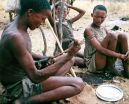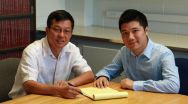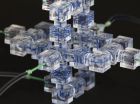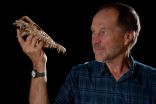(Press-News.org) SALT LAKE CITY, Sept. 22, 2014 – After human ancestors controlled fire 400,000 to 1 million years ago, flames not only let them cook food and fend off predators, but also extended their day.
A University of Utah study of Africa's Kalahari Bushmen suggests that stories told over firelight helped human culture and thought evolve by reinforcing social traditions, promoting harmony and equality, and sparking the imagination to envision a broad sense of community, both with distant people and the spirit world.
Researchers previously studied how cooking affected diets and anatomy, but "little is known about how important the extended day was for igniting the embers of culture and society," anthropology professor Polly Wiessner writes in a study published online today in the journal Proceedings of the National Academy of Sciences.
"There is something about fire in the middle of the darkness that bonds, mellows and also excites people. It's intimate," says Wiessner, who has studied the Bushmen for 40 years. "Nighttime around a fire is universally time for bonding, for telling social information, for entertaining, for a lot of shared emotions."
Wiessner's study, which she calls "exploratory," analyzed scores of daytime and firelight conversations among !Kung Bushmen – also known as Ju/'hoansi Bushmen – some 4,000 of which now live in the Kalahari Desert of northeast Namibia and northwest Botswana. (The exclamation, slash and apostrophe symbols represent click sounds in their language.) They are among several groups of Kalahari Bushmen.
Why study the campfire tales of Bushmen?
"We can't tell about the past from the Bushmen," Wiessner says. "But these people live from hunting and gathering. For 99 percent of our evolution, this is how our ancestors lived. What transpires during the firelit night hours by hunter-gatherers? It helps answer the question of what firelit space contributes to human life."
She writes: "Stories are told in virtually all hunter-gatherer societies; together with gifts, they were the original social media."
From the Workaday World to Nights of Bonding and Wonder
In her study, "Embers of Society: Firelight Talk among the Ju/'hoansi Bushmen," Wiessner says archaeological evidence indicates human ancestors had sporadic control of fire 1 million or more years ago, and regularly used it after 400,000 years ago.
"Fire altered our circadian rhythms, the light allowed us to stay awake, and the question is what happened in the fire-lit space? What did it do for human development?" asks Wiessner, who earlier this year was among three University of Utah researchers elected to the National Academy of Sciences.
Wiessner says !Kung Bushmen hold firelight gatherings most nights in groups of up to 15 people. A camp has hearths for each family, but at night people often converge at a single hearth. She analyzed only conversations involving five or more people.
Firelight stories deal with topics such as past hunts, fights over meat, marriage, premarital customs, murder, bush fires, birth, getting lost, interactions with other groups, truck breakdowns, being chased by animals, disputes and extramarital affairs. And there also are traditional myths.
For her study, Wiessner analyzed two sets of data:
Notes she took in 1974 (initially for another purpose) of 174 daytime and nighttime conversations at two !Kung camps in northwest Botswana. Each conversation lasted more than 20 to 30 minutes and involved five to 15 people.
Digital recordings, transcribed by educated Bushmen, of 68 firelight stories Wiessner originally heard in the 1970s but came back to have retold and recorded during three visits in 2011-2013 to !Kung villages in Botswana and Namibia.
Wiessner found daytime conversations differed much from firelight discussions. Of daytime conversations, 34 percent were complaints, criticism and gossip to regulate social relationships; 31 percent were economic matters, such as hunting for dinner; 16 percent were jokes; only 6 percent were stories and the rest were other topics
But at night, 81 percent of the conversations involved stories, and only 7 percent were complaints, criticism and gossip and 4 percent were economic.
Bonding with People Near and Far – and with the Supernatural
Wiessner found how conversations reinforced major !Kung social institutions and values: arranged marriages, the kinship system, a social structure based on equality, the sharing of food during times of hardship, land rights, trance healing and xaro, a system of exchange that involved pledges of mutual assistance, including housing and food, in troubled times.
"What I found was a big difference between day and night conversation, the kinds of information transmitted and the use of imaginary thought," Wiessner says.
"Day conversation has a lot to do with economic activities – working, getting food, what resources are where," she says. "It has a lot to do with social issues and controls: criticism, complaints and gripes."
"At night, people really let go, mellow out and seek entertainment. If there have been conflicts in the day, they overcome those and bond. Night conversation has more to do with stories, talking about the characteristics of people who are not present and who are in your broader networks, and thoughts about the spirit world and how it influences the human world. You have singing and dancing, too, which bonds groups."
Healers dance and go into trances, "travel to god's village and communicate with the spirits of deceased loved ones who are trying to take sick people away," Wiessner says.
She says nonhuman primates don't maintain mutually supportive ties outside their group: "We are really unique. We create far-flung ties outside our groups."
Such extended communities allowed humans "to colonize our planet because they had networks of mutual support, which you see expressed today in our capacity for social networking" she adds. "Humans form communities that are not together in space, but are in our heads – virtual communities. They are communities in our heads. For the Bushmen, they may be up to 120 miles away."
Wiessner suggests that firelight stories, conversations, ceremonies and celebrations sparked human imagination and "cognitive capacities to form these imagined communities, whether it's our social networks, all of our relatives on Earth or communities that link us to the spirit world." She says they also bolstered the human ability to "read" what others are thinking – not just their thoughts or intentions, but their views toward other people.
What Has Electricity Done to Us?
Examining how firelight extended the day prompted Wiessner to wonder about modern society, asking, "What happens when economically unproductive firelit time is turned to productive time by artificial lighting?"
Parents read stories or show videos to their children, but now, "work spills into the night. We now sit on laptops in our homes. When you are able to work at night, you suddenly have a conflict: 'I have only 15 minutes to tell my kids a bedtime story. I don't have time to sit around and talk.' Artificial light turned potential social time into potential work time. What happens to social relations?"
Her research raises that question, but doesn't answer it.
INFORMATION:
University of Utah Communications
75 Fort Douglas Boulevard, Salt Lake City, UT 84113
801-581-6773 fax: 801-585-3350
unews.utah.edu
Firelight talk of the Kalahari Bushmen
Did tales told over fires aid our social and cultural evolution?
2014-09-22
ELSE PRESS RELEASES FROM THIS DATE:
University of Utah engineers unlock potential for faster computing
2014-09-22
SALT LAKE CITY, Sept. 22, 2014 – University of Utah engineers discovered a way to create a special material – a metal layer on top of a silicon semiconductor – that could lead to cost-effective, superfast computers that perform lightning-fast calculations but don't overheat.
This new "topological insulator" behaves like an insulator on the inside but conducts electricity on the outside and may pave the way for quantum computers and fast spintronic devices.
The research, led by University of Utah materials science and engineering professor Feng Liu, was published today ...
Lego-like modular components make building 3-D 'labs-on-a-chip' a snap
2014-09-22
Thanks to new LEGO®-like components developed by researchers at the USC Viterbi School of Engineering, it is now possible to build a 3-D microfluidic system quickly and cheaply by simply snapping together small modules by hand.
Microfluidic systems are used in many fields including engineering, chemistry and biotechnology to precisely manipulate small volumes of fluids for use in applications such as enzymatic or DNA analysis, pathogen detection, clinical diagnostic testing, and synthetic chemistry. Traditionally, microfluidic devices are built in a cleanroom on a two-dimensional ...
Platelets modulate clotting behavior by 'feeling' their surroundings
2014-09-22
Platelets, the tiny cell fragments whose job it is to stop bleeding, are very simple. They don't have a cell nucleus. But they can "feel" the physical environment around them, researchers at Emory and Georgia Tech have discovered.
Platelets respond to surfaces with greater stiffness by increasing their stickiness, the degree to which they "turn on" other platelets and other components of the clotting system, the researchers found.
"Platelets are smarter than we give them credit for, in that they are able to sense the physical characteristics of their environment and ...
Genetic switch regulates a plant's internal clock based on temperature
2014-09-22
Scientists have discovered a key molecular cog in a plant's biological clock – one that modulates the speed of circadian (daily) rhythms based on temperature.
Transcription factors, or genetic switches, drive gene expression in plants based on external stresses – such as light, rain, soil quality, or even animals grazing on them. A team of researchers at USC has isolated one, called FBH1, that reacts to temperature – tweaking the rhythm here and there as needed while in keeping it on a consistent track.
"Temperature helps keep the hands of the biological clock in the ...
Massachusetts General study reveals gene expression patterns in pancreatic CTCs
2014-09-22
Analysis of circulating tumor cells (CTCs) in a mouse model of pancreatic cancer identified distinct patterns of gene expression in several groups of CTCs, including significant differences from the primary tumor that may contribute to the ability to generate metastases. In their study reported in the Sept. 25 issue of Cell Reports, investigators from the Massachusetts General Hospital (MGH) Cancer Center identified several different classes of pancreatic CTCs and found unexpected factors that may prove to be targets for improved treatment of the deadly tumor.
"Our ...
Infant solar system shows signs of windy weather
2014-09-22
Astronomers using the Atacama Large Millimeter/submillimeter Array (ALMA) have observed what may be the first-ever signs of windy weather around a T Tauri star, an infant analog of our own Sun. This may help explain why some T Tauri stars have disks that glow weirdly in infrared light while others shine in a more expected fashion.
T Tauri stars are the infant versions of stars like our Sun. They are relatively normal, medium-size stars that are surrounded by the raw materials to build both rocky and gaseous planets. Though nearly invisible in optical light, these disks ...
Old drug may be key to new antibiotics
2014-09-22
Hamilton, ON (September 22, 2014) – McMaster scientists have found that an anticonvulsant drug may help in developing a new class of antibiotics.
Although dozens of antibiotics target what bacteria do, their study has looked at how a certain part of bacteria are created, and they found there is a way of stopping it.
The discovery is important as there is growing concern worldwide about how antibiotic resistance is making the cures for infections ineffective. The World Health Organization has declared that antibiotic resistance is a major threat to global health security. ...
Answer to restoring lost island biodiversity found in fossils
2014-09-22
GAINESVILLE, Fla. --- Many native species have vanished from tropical islands because of human impact, but University of Florida scientists have discovered how fossils can be used to restore lost biodiversity.
The key lies in organic materials found in fossil bones, which contain evidence for how ancient ecosystems functioned, according to a new study available online and in the September issue of the Journal of Herpetology. Pre-human island ecosystems provide vital clues for saving endangered island species and re-establishing native species, said lead author Alex Hastings, ...
Higher risk of heart disease for South Asians in Canada
2014-09-22
Hamilton, ON (September 22, 2014) – South Asians living in Canada have a higher rate of heart disease and double the rate of diabetes compared with while people, McMaster researchers have found.
The paper was published today in the Canadian Medical Association Journal (CMAJ Open) and may be found at http://www.cmajopen.ca/content/2/3/E183.full
One of the fastest-growing ethnic groups in the country is the more than one million South Asian people living in Canada, comprising about three percent of the population. They include people from India, Pakistan, Sri Lanka, ...
Snail shells show high-rise plateau is much lower than it used to be
2014-09-22
The Tibetan Plateau in south-central Asia, because of its size, elevation and impact on climate, is one of the world's greatest geological oddities.
At about 960,000 square miles it covers slightly more land area than Alaska, Texas and California combined, and its elevation is on the same scale as Mount Rainier in the Cascade Range of Washington state. Because it rises so high into the atmosphere, it helps bring monsoons over India and other nations to the south while the plateau itself remains generally arid.
For decades, geologists have debated when and how the plateau ...
LAST 30 PRESS RELEASES:
Mysterious iron ‘bar’ discovered in famous nebula
World-first tool reduces harmful engagement with AI-generated explicit images
Learning about public consensus on climate change does little to boost people’s support for action, study shows
Sylvester Cancer Tip Sheet for January 2026
The Global Ocean Ship-Based Hydrographic Investigations Program (GO-SHIP) receives the Ocean Observing Team Award
Elva Escobar Briones selected for The Oceanography Society Mentoring Award
Why a life-threatening sedative is being prescribed more often for seniors
Findings suggest that certain medications for Type 2 diabetes reduce risk of dementia
UC Riverside scientists win 2025 Buchalter Cosmology Prize
SETI Institute opens call for nominations for the 2026 Tarter Award
Novel theranostic model shows curative potential for gastric and pancreatic tumors
How beige fat keeps blood pressure in check
Fossils reveal ‘latitudinal traps’ that increased extinction risk for marine species
Review: The opportunities and risks of AI in mental health research and care
New map reveals features of Antarctic’s ice-covered landscape
Beige fat promotes healthy vascular function and blood pressure in mice
Chronic low-dose pesticide exposure reduces the life span of wild lake fish, China-based study shows
Tiny earthquakes reveal hidden faults under Northern California
Long-term pesticide exposure accelerates aging and shortens lifespan in fish
Professor Tae-Woo Lee's research group develops groundbreaking perovskite display technology demonstrating the highest efficiency and industry-level operational lifetime
The “broker” family helps tidy up the cell
Ecology: Mummified cheetahs discovery gives hope for species’ Arabic reintroduction
Researchers survey the ADHD coaching boom
Air pollution and cardiac remodeling and function in patients with breast cancer
Risk of suicide in patients with traumatic injuries
Post–intensive care syndrome
The lifesaving potential of opioid abatement funds
The Frontiers of Knowledge Award goes to Allan MacDonald and Pablo Jarillo-Herrero for their discovery of the “magic angle” enabling science to transform and control the behavior of new materials
Discovery reveals how keto diet can prevent seizures when drugs fail
JMIR Publications and Sikt announce pilot flat-fee unlimited open access partnership
[Press-News.org] Firelight talk of the Kalahari BushmenDid tales told over fires aid our social and cultural evolution?









